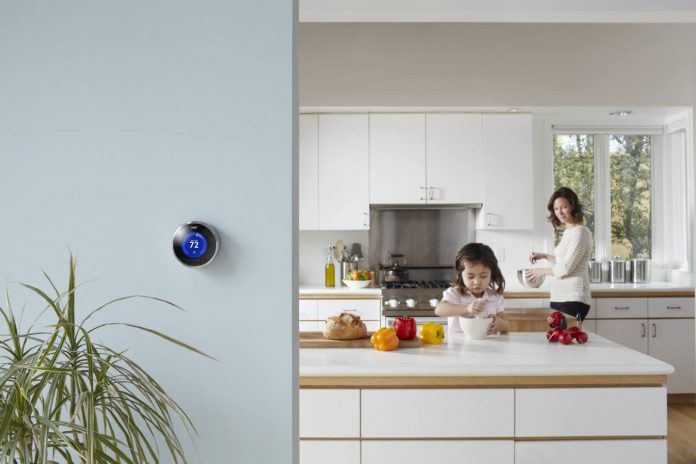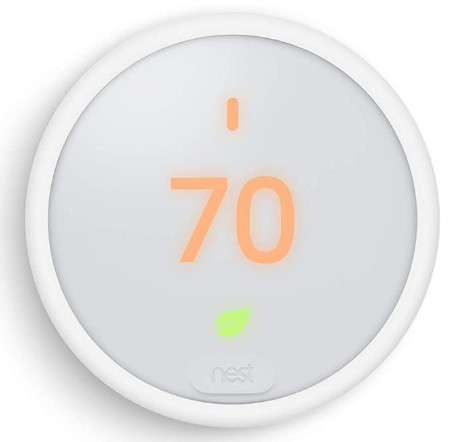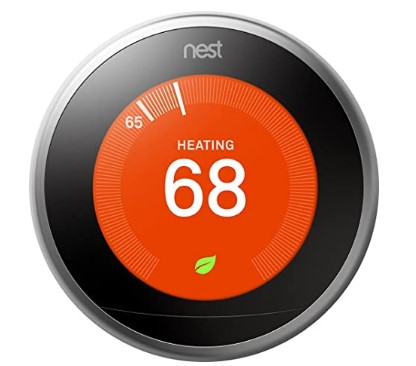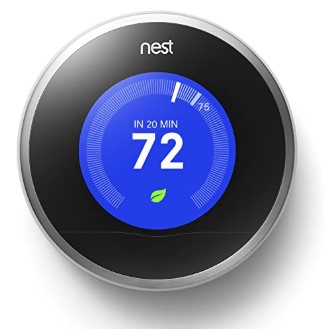A Comprehensive Nest Thermostat Review
The Nest thermostats are undeniably one of the best digital thermostats in the market. Their intuitive design and seamless integration into a modern-day smart home makes them, as you would see in this Nest thermostat review, my personal favorite. Even if you were new to digital thermostats, you most probably would have heard of The Nest’s second-generation, or the latest and most impressive, the third generation Nest thermostats that went live in September 2015.
What is the Best Nest Thermostat?
The Complete Nest Thermostat Review
Nest Labs designs minimalistic knob-shaped thermostats that have a rather captivating futuristic look. If you want something that is tiny and powerful, you will find the Nest’s know design quite fulfilling. The knob is all you need to control the room temperature while the screen lights up when you pass by letting you see the current temperature and working mode without pushing or touching anything. Go through my Nest thermostat review to learn more.
The entire series of Nest Learning Thermostats will save 10-12 percent on heating and up to 15 percent in cooling costs. By learning from you and using this knowledge to program itself, the Nest creates the perfect dynamic thermostat that can work on autopilot or take in remote instructions from your portable devices.
Nest Learning Thermostats
While buying a third-generation Nest thermostat would be a great idea, you might want to go back into the first or second generation catalog to find the best value for your money.
Nest Thermostat E ( 4th Generation Nest)
Even more surprisingly, there isn’t a stark difference between the 3rd Gen and 4th Generation Nest in performance. However, the low price means that they had to sacrifice some of the features. This includes replacing the metal sides with a plastic coasting and installing a frosted glass at the expense of a clear one.
Despite this, you will enjoy the same performance from Nest which includes features like remote control, geo-fencing, and compatibility with Alexa and Google Assistant. However, like all other generations, the 4th Gen Nest doesn’t support Apple Homekit.
Nest Learning Thermostat 3rd Generation
The third-generation Nest thermostat adopts modern connectivity and displays to make everything even better. A more aggressive artificial intelligence makes the auto-schedule feature more reliable meaning that you won’t have to waste time programming the third-gen nest to suit your needs.
The display screen gets an upgrade to a 24-bit color LCD with an impressive 480×480 resolution while the Alexa for voice control compatibility adds something tangible to the already impressive control catalog.
Combining this with the tested and proven Nest thermostat from the previous generations gives you a modernized thermostat that will definitely help you keep a tight leash on your utility bills in style.
Nest Learning Thermostat 2nd Generation
The T200577 programmable thermostat takes after its predecessor, the first generation Nest thermostat and perfects the lovable learning model.
The 2-generation design makes this smart thermostat 20 percent thinner while its tenacity makes it compatible with up to 95 percent of the homes suffering from low or fluctuating voltage systems. By perfecting the learning model, the Nest 2nd-gen thermostat gives you an edge over first generation modules.
You will get more versatility and better learning with this Nest thermostat without losing the convenient Wi-Fi control or the intuitive knob design with a simple yet functional digital display unit. With an up to 95 percent compatibility with existing heating and cooling systems and capabilities to run without installing a C-wire, it is definitely a better option to most homeowners who aren’t willing to remodel their HVAC system to accommodate the Nest.
Nest Learning Thermostat 1st Generation (T100577)
A comprehensive Nest thermostat review proves that it packs all the basic features you would expect in a smart thermostat; auto schedule, smartphone, laptop or tablet remote control over Wi-Fi, an Auto-Away mode that shuts everything down when you are gone, an energy history module that shows you energy consumption and most importantly the Auto Schedule feature that learns from your previous temperature preferences.
By maintaining the same design throughout its three generations of digital thermostats, The Nest not only guarantees compatibility but also keeps the learning curve fairly leveled no matter what Nest thermostat you buy.
The three generations of the Nest learning thermostat are eerily similar. They all share a ton of amazing features and looks. As you would expect, things get better with each iteration. Here is how to tell what thermostat you have.
Why I Love the Nest
The Nest’s most notable feature would be the auto learn feature. Nest Labs has been moving away from the programmable thermostat theory into a more modernized intelligent gadget that learns your behavior and uses sensors to cement its optimizations. All it takes is a couple of days of subtle fiddling to teach it your detailed conditioning preferences.
- The GUI user interface and knob control is quite cool. Couple this with the bubble mounting panel and you get a thermostat that is as aesthetic as it is functional. You have the option of purchasing your own mounting panel if you want to customize your installation further.
- A detailed compatibility with different kinds of HVAC systems will help you get the perfect settings for your home. You can choose this during the configuration run.
- Impressive learning capabilities even with little or no manual programming making it simple to use for most homeowners. All you have to do is adjust the temperatures to your desired level and it will pick the trend.
- A convenient smartphone and PC app that lets you program your Nest thermostat from an ample user interface.
- Tons of pre-installed thermostat settings that will pretty match cater for even the refined air conditioning needs
- The Nest leaf will come on when you choose an eco-friendly setting and the history tab will make you feel proud of your investment whenever you save more and more on air conditioning.
How to Install the Nest Thermostat
Most of the homeowners will always think of compatibility and ease of installation when choosing a new digital thermostat. The designers over at Nest Labs made installing the Nest programmable thermostats as easy as removing the old thermostat, installing the base plate, connecting the wires and plugin in the new Nest thermostat. They will even provide you with the screwdriver you need to do the installation.
Check this too: Lennox iComfort Thermostat Troubleshooting
The Nest will work with up to 95 percent of the systems in the market. It doesn’t matter whether you are running a heat pump, forced air system or gas air conditioning. You can easily replace your existing thermostat with the innovative Nests and you are good to go. Just remember that this thermostat works with low voltage systems (24V)
Nest Labs has provided a compatibility widget to help you gauge your system compatibility before you purchase your thermostat. If your system is compatible and you want to do some DIY installation, a brief nest thermostat installation guide should teach you the basics within no time.
Confirming Compatibility
To confirm compatibility, use the Nest compatibility tool that will require your current wiring layout to generate a custom wiring diagram. Use the photo you just took to feed the compatibility tool and customize it to fit your system.
Some thermostats might have two sets of labels on each connector to the old thermostat. One of the connectors is for heat pump systems and the other is for conventional systems. This quick guide will help you find out which information to feed into the compatibility tool.
Don’t bother to use the compatibility checker if
- You use a high voltage system. Systems labeled 240V or 120V are beyond the Nests docket. A common characteristic of high voltage systems is thick gauge wires with wire nut connections
- Your old system used stranded wires. These are another indicator that your system is a high voltage (line voltage unit)
Nest Thermostat Installation Pro Tips
- Remember to label your wires when disconnecting them from the old thermostat. Use some masking tape or labeling tags and scribble the socket each wire was hooked into on your old thermostat
- Roll the thermostat wires around a pencil or stick to prevent them from falling into the hole in the wall before you can hook them up to the thermostat
- Always fit the base plate and ensure its neat and presentable before you begin wiring the Nest thermostat
- Each terminal on the Nest base takes one wire. Slot in the right wire to the right terminal. The terminal button will stay down if you have locked the wire in place properly
Nest Thermostat Installation Manual
The following Nest thermostat installation manual will teach you how to hook up the thermostat to the wall, set it up, add it to your Nest account and start using it all on your own. By this step, you should have confirmed that your existing installation wiring is compatible with your new Nest thermostat. Here is a brief compatibility test guide
Before starting the installation, take a picture of your current thermostat connection so that you can remember where each wire goes. This is important since different thermostats and regions use different color codes making it hard to identify a cable by its color.
Power off your AC at the circuit breaker and give it some time to prove it is off by surveying a steady temperature drop on your thermostat. If your thermostat doesn’t have a battery, it will go off once you turn off the power.
Remove the thermostat cover to expose the wiring and labeled plate before taking the photos. Some thermostats might have a second plate obscuring these. Remove it before taking the photo. Ensure that it is a clear photo and you can read all the labels and wording
Letting a Nest Pro handle the installation gives you access to a lucrative extended five-year warranty. The guarantee compared to the cost to install the thermostat is always worth it. However, if you want the satisfaction of a DIY project, here are the steps to follow
Once the thermostat is in place, you can power up your AC, hence the thermostat and follow the Configuration Wizard to connect to the home Wi-Fi and the internet. You will nee this connection if you want to use your Nest account to unleash the full potential of your account.
Nest Remote Control
The Wi-Fi control over the Nest App makes this thermostat quite delighting as you can keep an eye at your home from wherever you please. My Nest thermostat review proves that each thermostat comes Wi-Fi ready. It will latch into your Wi-Fi and you can immediately control it using your laptop, tablet or smartphone.
The app lets you change temperatures, edit schedules, and view comprehensive usage reports. You will even get a monthly newsletter with summaries and hints on how to better your energy savings.
Check this too:Best Touchscreen Thermostat
With a fully encrypted connection, you needn’t worry about someone hijacking your air conditioning. Just remember to set a strong password and keep it off prying eyes.
Why Pay More for a Second or Third Generation Nest?
While you might argue that the first generation is enough automation to your home, I would give you a couple of reasons why you should get the third generation Nest thermostat – if you can afford it.
- A bigger brighter screen makes it easier to navigate through the setting or view the settings from a distance. The 3rd generation has a 40% large screen but still maintains the size (20 percent thinner than 1st generation)
- The FarSight detector makes Nest 3 more sensitive to motion. It will light up when you pass up to 20 feet away meaning that it can auto-learn when you are away better and faster.
If you are not willing to spend an extra 50 or so bucks for a bigger screen or better sensors, you could still make do with the second generation thermostat or even go as low as the first generation Nest thermostats – assuming you can still get your hands on one.
Do You Really Need the Nest Account?
Before moving on…
I hope our Nest thermostat review overlook shed some light on your search. Buying a smart digital thermostat for the first time might be quite the challenge. There are so many things to look at and compare before making your final decision. The in-depth reviews for each Nest thermostat will come in handy when making these decisions.
Feel free to look at the comparison page that’s dedicated to comparing the different smart thermostats I have on my website. If you are confident that Nest thermostats are the best for you, can check out the second generation thermostat or the third generation here.
Common Nest Installation Problems & Questions Solved
Do You Need a Nest Account to Run the Nest Thermostat?
A Nest Account gives you a great way to monitor all your Nest products whilst giving you full access to the thermostat through the Nest app. The account is however optional and you can still run your Nest thermostat without connecting to the Nest Account only that you will lose the seamless anywhere control features.
How do I Register My Nest Thermostat?
You don’t have to register your Nest thermostat to start heating or cooling your house. Connecting to the internet and your Nest account only gives you remote access and all other cool Nest App features. Connect the thermostat to your Wi-Fi. Turn the ring to highlight a letter and press it to select it. You can use shift to toggle through uppercase, lowercase, numbers and punctuation.
Once connected to the Wi-Fi, you can use your smartphone and the Nest app you downloaded above to finish all the advanced Nest thermostat configurations.
Check this too: Nest Thermostat Troubleshooting Guide
How do You Reset a Nest Thermostat?
Resetting your thermostat will resolve problems like a slow or frozen display and failure to connect to the Wi-Fi but will wipe out all your settings and what the thermostat learned about your home. A good alternative would be restarting the thermostat.
To reset:
- Press thermostat ring to open Quick View menu
- Click on the settings icon
- Turn the ring to highlight Reset and press the ring to select
How do I Manually Restart the Nest Thermostat?
- Press and hold down the thermostat ring for 10 seconds, or until the screen goes off. Give it some 20 seconds to ensure it finishes shutting down
- Press and release the ring to initiate the restart process
How do I Change Nest Thermostat Wi-Fi Password after Replacing My Router?
The best thing to do after replacing your router is to give your Wi-Fi the same SSID (network name) and password as before so that your Nest gadgets can connect automatically. If this isn’t possible or fails to work, you will need to change the settings on the thermostat (you can’t change Wi-Fi information using the mobile app)
- Press thermostat ring to enter menu
- Select settings
- Turn the ring to select Reset
- Select Network
- Confirm reset. This will reset your network configurations only forcing you to sign in afresh
- Navigate the the Settings menu and select Network
- Wait for the thermostat to register the new Wi-Fi network name then select the name and enter the password to that network to connect
If you are still facing issues with your thermostat, then check out our comprehensive Nest thermostat troubleshooting guide.
Nest and Nest thermostats have been around for a while. Their compelling DIY approach and the sheer beauty of the thermostat has made it a delight to many homeowners. It could be a great smart move for your home especially if you are looking for something that pushes regular updates, has cutting edge learning and wireless control features and has a future. Nest thermostat might be a new kid in the thermostat block but there are already rumors that they are working on a new and better 4th generation Nest Thermostat.



